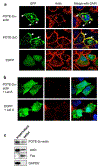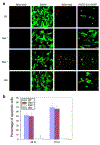A primate-specific POTE-actin fusion protein plays a role in apoptosis
- PMID: 19669888
- PMCID: PMC7285894
- DOI: 10.1007/s10495-009-0392-0
A primate-specific POTE-actin fusion protein plays a role in apoptosis
Abstract
The primate-specific gene family, POTE, is expressed in many cancers but only in a limited number of normal tissues (testis, ovary, prostate). The 13 POTE paralogs are dispersed among 8 human chromosomes. They evolved by gene duplication and remodeling from an ancestral gene, Ankrd26, recently implicated in controlling body size and obesity. In addition, several POTE paralogs are fused to an actin retrogene producing POTE-actin fusion proteins. The biological function of the POTE genes is unknown, but their high expression in primary spermatocytes, some of which are undergoing apoptosis, suggests a role in inducing programmed cell death. We have chosen Hela cells as a model to study POTE function in human cancer, and have identified POTE-2alpha-actin as the major transcript and the protein it encodes in Hela cells. Transfection experiments show that both POTE-2alpha-actin and POTE-2gammaC are localized to actin filaments close to the inner plasma membrane. Transient expression of POTE-2alpha-actin or POTE-2gammaC induces apoptosis in Hela cells. Using wild-type and mutant mouse embryo cells, we find apoptosis induced by over-expression of POTE-2gammaC is decreased in Bak ( -/- ) or Bak ( -/- ) Bax ( -/- ) cells indicating POTE is acting through a mitochondrial pathway. Endogenous POTE-actin protein levels but not RNA levels increased in a time dependent manner by stimulation of death receptors with their cognate ligands. Our data indicates that the POTE gene family encodes a new family of proapoptotic proteins.
Conflict of interest statement
Figures





References
-
- Jin Z, El-Deiry SW (2005) Overview of cell death signaling pathways. Cancer Biol Ther 4:139–163 - PubMed
-
- O’ Brien DI, Nally K, Kelly RG, O’Connor TM, Shanahan F, O’Connell J (2005) Targeting the Fas/Fas ligand pathway in cancer. Expert Opin Ther Targets 9:1031–1044 - PubMed
-
- Nagata S, Golstein P (1995) The Fas death factor. Science 267:1449–1456 - PubMed
-
- Fletcher J, Huang D (2008) Controlling the cell death mediators Bax and Bak: puzzles and conundrums. Cell Cycle 7:39–44 - PubMed
-
- Reichmann E (2002) The biological role of the Fas/FasL system during tumor formation and progression. Semin Cancer Biol 12:309–315 - PubMed
Publication types
MeSH terms
Substances
Grants and funding
LinkOut - more resources
Full Text Sources
Molecular Biology Databases
Research Materials

